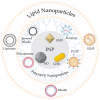Plasmid Gene Therapy for Monogenic Disorders: Challenges and Perspectives
- PMID: 39861752
- PMCID: PMC11768343
- DOI: 10.3390/pharmaceutics17010104
Plasmid Gene Therapy for Monogenic Disorders: Challenges and Perspectives
Abstract
Monogenic disorders are a group of human diseases caused by mutations in single genes. While some disease-altering treatments offer relief and slow the progression of certain conditions, the majority of monogenic disorders still lack effective therapies. In recent years, gene therapy has appeared as a promising approach for addressing genetic disorders. However, despite advancements in gene manipulation tools and delivery systems, several challenges remain unresolved, including inefficient delivery, lack of sustained expression, immunogenicity, toxicity, capacity limitations, genomic integration risks, and limited tissue specificity. This review provides an overview of the plasmid-based gene therapy techniques and delivery methods currently employed for monogenic diseases, highlighting the challenges they face and exploring potential strategies to overcome these barriers.
Keywords: gene therapy; monogenic diseases; non-viral vector; pDNA.
Conflict of interest statement
The authors declare no conflicts of interest.
Figures


References
Publication types
Grants and funding
LinkOut - more resources
Full Text Sources

